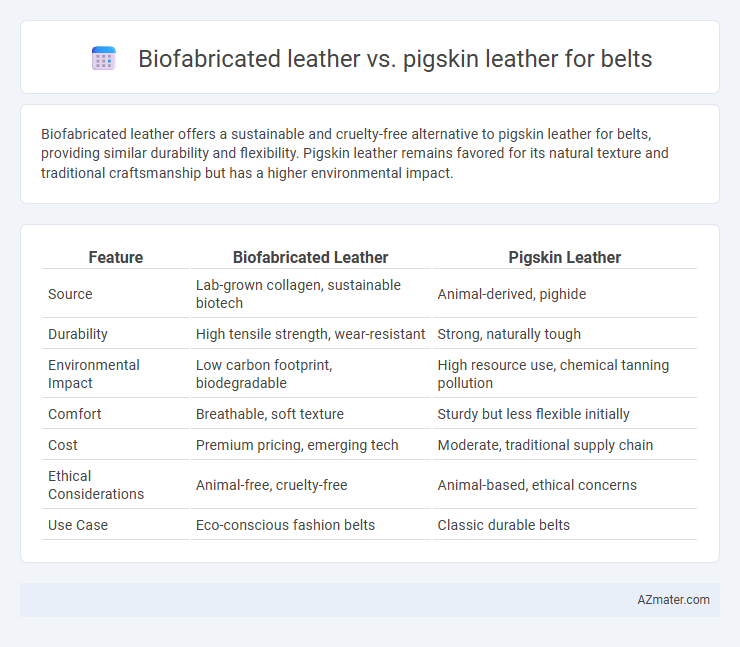Biofabricated leather offers a sustainable and cruelty-free alternative to pigskin leather for belts, providing similar durability and flexibility. Pigskin leather remains favored for its natural texture and traditional craftsmanship but has a higher environmental impact.
Table of Comparison
| Feature | Biofabricated Leather | Pigskin Leather |
|---|---|---|
| Source | Lab-grown collagen, sustainable biotech | Animal-derived, pighide |
| Durability | High tensile strength, wear-resistant | Strong, naturally tough |
| Environmental Impact | Low carbon footprint, biodegradable | High resource use, chemical tanning pollution |
| Comfort | Breathable, soft texture | Sturdy but less flexible initially |
| Cost | Premium pricing, emerging tech | Moderate, traditional supply chain |
| Ethical Considerations | Animal-free, cruelty-free | Animal-based, ethical concerns |
| Use Case | Eco-conscious fashion belts | Classic durable belts |
Introduction to Biofabricated Leather and Pigskin Leather
Biofabricated leather is a sustainable alternative created using cultured collagen produced by microorganisms, offering an eco-friendly and cruelty-free option for belt manufacturing. Pigskin leather, derived from the skin of pigs, is valued for its durability, natural grain texture, and breathability, making it a traditional choice in belt crafting. Comparing these materials highlights the innovation of biofabricated leather in reducing environmental impact while maintaining performance attributes found in classic pigskin belts.
The Process of Producing Biofabricated Leather
Biofabricated leather is created through a sustainable process that involves cultivating collagen proteins from microbial fermentation, which are then assembled into a leather-like material using bioengineering techniques. This method significantly reduces the environmental impact compared to traditional pigskin leather, which requires animal husbandry, slaughtering, and extensive chemical tanning processes. The production of biofabricated leather offers a controlled, scalable, and cruelty-free alternative, enhancing durability and consistency for belt manufacturing.
Traditional Pigskin Leather: Sourcing and Manufacturing
Traditional pigskin leather for belts is sourced primarily from domestic pigs raised in controlled farming environments, ensuring consistent hide quality with natural grain and durability. The manufacturing process involves tanning methods such as chrome or vegetable tanning to enhance the leather's strength, flexibility, and resistance to wear. This time-tested technique produces belts prized for their robust texture and ability to develop a unique patina over time, reflecting genuine animal-derived material properties.
Environmental Impact: Sustainability Comparison
Biofabricated leather significantly reduces environmental impact by using lab-grown cells, minimizing water consumption, deforestation, and greenhouse gas emissions compared to pigskin leather, which requires resource-intensive animal farming and contributes to methane release. The production of biofabricated leather also bypasses harmful tanning chemicals typically used in pigskin leather processing, decreasing soil and water pollution. Sustainability assessments highlight biofabricated leather as a more eco-friendly alternative, promoting circular economy principles and lowering the carbon footprint of belt manufacturing.
Durability and Longevity of Each Leather Type
Biofabricated leather exhibits high durability and resists cracking and wear due to its engineered fiber structure, making it a sustainable alternative for belts with extended longevity. Pigskin leather is renowned for its toughness and natural grain, offering strong resistance to abrasion and aging, which ensures belts made from pigskin last for years with proper care. While pigskin naturally develops a patina adding character over time, biofabricated leather maintains consistent performance without deterioration, making both suitable depending on usage preferences.
Aesthetic Qualities: Texture, Color, and Finish
Biofabricated leather offers a smooth, uniform texture with customizable color options that enhance its modern aesthetic appeal, while pigskin leather showcases natural grain patterns and slight variations in hue, providing a classic, rugged look. The finish of biofabricated leather tends to be more consistent and resistant to wear, maintaining a sleek appearance over time, whereas pigskin leather develops a rich patina with use, adding character and depth. Both materials present unique tactile experiences, with biofabricated leather feeling supple yet engineered, and pigskin offering a more organic, textured touch.
Comfort and Wearability for Belt Usage
Biofabricated leather offers superior breathability and flexibility compared to traditional pigskin leather, enhancing comfort for prolonged belt wear. Pigskin leather, while durable, tends to be stiffer initially and may require a break-in period that affects immediate wearability. The moisture-wicking properties of biofabricated leather reduce skin irritation and improve overall comfort, making it ideal for daily use belts.
Ethical Considerations: Animal Welfare and Biotechnology
Biofabricated leather eliminates the need for animal slaughter, providing a cruelty-free alternative that aligns with increasing consumer demand for ethical fashion products. Pigskin leather, derived from pigs, raises significant animal welfare concerns due to intensive farming practices and ethical issues surrounding animal use in the leather industry. Biotechnology advancements enable biofabricated leather production with minimal environmental impact and no exploitation of animals, making it a sustainable and ethically responsible choice for belt manufacturing.
Cost and Market Availability of Biofabricated vs Pigskin Belts
Biofabricated leather belts typically command higher prices due to advanced production technology and limited manufacturing scale, contrasting with pigskin leather belts which are more cost-effective owing to established, mass-market supply chains. Market availability of biofabricated leather belts remains limited and focused on niche, sustainable consumer segments, whereas pigskin leather belts are widely accessible across global retail and wholesale channels. Production costs for biofabricated leather continue to decrease as technology advances, but pigskin leather benefits from decades of optimized tanning and distribution infrastructure.
Consumer Trends and Future Outlook for Leather Belts
Biofabricated leather is gaining traction among eco-conscious consumers seeking sustainable alternatives to traditional pigskin leather belts, driven by growing demand for cruelty-free and environmentally friendly materials. Innovations in biofabrication technology enable scalable production of high-quality, durable leather that mimics the texture and strength of pigskin, appealing to both mainstream and luxury markets. Future outlook for leather belts sees a shift toward biofabricated options as regulatory pressures increase and consumer preference favors circular fashion and reduced carbon footprints.

Infographic: Biofabricated leather vs Pigskin leather for Belt
 azmater.com
azmater.com